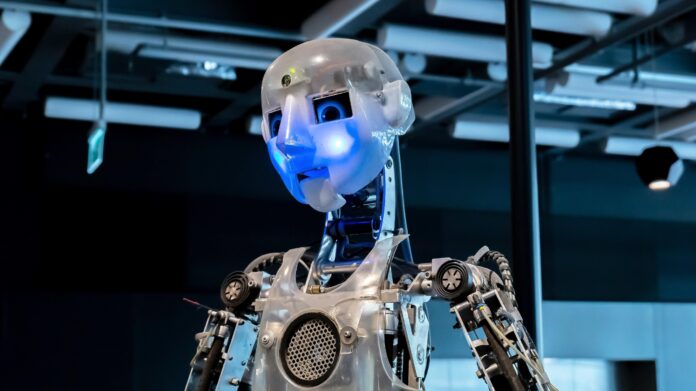OpenAI, Nvidia and Tesla, along with Chinese companies, are setting new standards in the global competition of AI and humanoid robotics. The development of intelligent machines in industry and everyday life is shaped by advances in AI systems and language models.
The global competition among large language models is heating up, with major players competing for dominance on AI reasoning capabilities and costs efficiency. OpenAI is at the forefront of artificial intelligence with its ChatGPT and DeepSeek systems. Both have pushed the limits of the technology.
In this AI arms race OpenAI’s latest technology is a standout.
The trademark application filed with the United States Patent and Trademark Office shows that the organization’s goals go beyond LLMs. The application lists a variety of hardware, including AI-powered smart devices and augmented and virtual reality headsets. It even includes humanoid robotics.
Sam Altman confirmed to the press that OpenAI is researching AI-powered consumer electronics and is working with multiple companies to do so. OpenAI, reportedly, is also developing its own semiconductor technologies to support these AI initiatives.
OpenAI’s entry into robotics
To industry tech enthusiasts, the mention of robots humanoid in OpenAI’s trademark application indicates a possible return to Robotics. The company invested in companies such as Figure and 1X after closing its robotics division in 2020. OpenAI seems to be reconsidering the possibility of AI-driven robots for real world applications, given advances in AI and sensors technology. This is not surprising.
Goldman Sachs Researchpredicts, for example, that the humanoid robotic market could reach $ 38 billion in 2035, which is a six-fold rise over earlier estimates.
NVIDIA’s AI-driven robotics offensive
OpenAI, however, is not the only company that is betting and driving the increasing convergence between AI and robots. NVIDIA introduced Cosmos at CES 2025. It is a platform for World Foundation Models that allows AI-driven decisions to be made for robotics and autonomous cars. Cosmos allows AI models to generate realistic scenarios and simulate environments, which accelerates training for humanoid robotics.
NVIDIA has also introduced the Isaac Blueprint for generating synthetic movement that supports the training humanoid robotics using imitation learning. NVIDIA’s goal is to advance AI-driven automation of physical systems by utilizing synthetic data and reinforcement training. The Cosmos platform includes AI models that have been trained on massive datasets including two million hours footage on autonomous driving and robotics.
China’s rapid advancements in humanoid robots
China is aggressively developing its industry of humanoid robots, with government-led efforts advancing the goal of mass production by 2020. Nearly 30 companies presented state-of-the art humanoid robots at a recent event held in Beijing. Last year,
102 humanoid robotics from 10 different companies were gathered in a 4,000 square meter facility in Shanghai, to demonstrate tasks like walking, making beds and washing dishes.
The integration of robotics in cultural events is another way to highlight China’s innovative power. Humanoid robots performed a Yangge folk dance at the Spring Festival Gala. They combined traditional heritage with advanced AI movement. This is a great example of China’s vision to seamlessly integrate robots into daily life.
Elon Musk is also optimistic about Tesla’s plans in the area of humanoid robotics. Tesla announced its plans to produce thousands Optimus-Humanoid Robots by 2025 when announcing results for the fourth quarter in 2024. The production will then grow exponentially.
Figure AI, an American robotics company based in California, has ended their partnership with OpenAI. OpenAI was formed only in February 2024. Brett Adcock, CEO and founder of Figure, explained on X that large language models are becoming more powerful but also more commoditized. For Figure, LLMs became the smallest part of the puzzle while the more difficult part was to develop new AI models for high frequency robot control.
LLMs have become more and more commoditized, but they are still getting smarter. LLMs have become a small piece of the puzzle for us.
https://t.co/tAn7YfZhKl— Brett Adcock (@adcock_brett)
Adcock announced Figure’s major breakthrough in an end-to-end robotic artificial intelligence that was developed in-house on February 5, 2025.
The company will demonstrate something that has never been seen before in the form of a humanoid robotic. Figure has won the business of several large companies, including
BMWThe company plans to deliver 100,000 robotics over the next 4 years.
AI and robotics – a symbiotic relationship
The exponential advancements in AI, especially in large language models, and machine learning are laying the groundwork for the next generation humanoid machines. AI-driven robots have great potential for industrial applications ranging from manufacturing to logistics. Regulatory frameworks, cost-efficiency, and barriers to market adoption remain challenges.
As AI continues to develop at a rapid pace, the next few years will determine just how seamlessly these intelligent machines are integrated into human-centered environments. AI-first is transforming the future of humanoid robotics, whether in industrial automation, personal assistant or entertainment.
Jan Burian is an author, speaker and analyst who specializes in disruptive digital technologies. He is currently the director of industry insights for .
Trask () is responsible for overseeing and executing a go-to-market marketing strategy, with a focus on the DACH area, especially Germany. The role involves content marketing, media relations and tracking IT and technological trends, particularly in the automotive and industry sectors.





